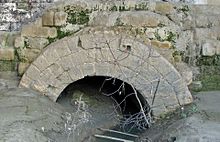Cloaca Maxima

The Cloaca Maxima (from Latin cluere ' to clean', Cloaca Maxima literally the largest sewer , derived from the German term cloaca ) is part of an ancient canal system in Rome .
The fifth king of Rome , Tarquinius Priscus , is said to have created an extensive canal system for draining the valley between the Palatine Hill and the Capitol , which later became the Roman Forum .
The most important of these canals was the Cloaca Maxima , which is considered a prototype for ancient sewer systems . The route of this system follows an originally natural, later canalised and straightened water course called Velabrum , which flows into the Tiber at Pons Aemilius . The dimensions of the Cloaca Maxima are up to 3 m wide and more than 4 m high. The sanctuary of Venus Cloacina was built to the goddess of this river, Venus Cloacina , in the Roman Forum .
The eleven aqueducts that supplied water to Rome in the 1st century AD were after many public baths such as the B. the Diocletian baths , public fountains, imperial palaces and private houses with water were connected to the canal system. The continued supply of running water helped wash away rubbish and keep the sewer system from clogging. The layers of deposits that had formed in the Cloaca Maxima over the centuries were removed in 1829 by the archaeologist Antonio Nibby .
Remarks
- ↑ Cf. Livius a. u. c. 1,38,6: infima urbis loca circa forum aliasque interiectas collibus convalles, quia ex planis locis haud facile evehebant aquas, cloacis fastigio in Tiberim ductis siccat ( He laid the lowlands of the city around the forum and other valleys between the hills (sc . Tarquinius Priscus ) through sewers that were led from above to the Tiber, dry because the water flowed out of the flat terrain with difficulty. ) About Tarquinius Superbus, Livius (1,56,2) writes: […] laboris aliquanto maioris traducebantur opera […] Cloacamque maximam, receptaculum omnium purgamentorum urbis, sub terra agendam. ( [...] Buildings with a lot more work were carried out [...] and the underground system of the Cloaca maxima, the waste water collection system for the city. ).
- ^ Ronald T. Ridley: Nibby, Antonio (1792-1839) . In: Nancy Thomson De Grummond (Ed.): Encyclopedia of the History of Classical Archeology . Routledge, London 2015.
literature
- Heinrich Bauer : Cloaca maxima. In: EM Steinby (Ed.): Lexicon Topographicum Urbis Romae. Volume 1. Rome 1993, pp. 288-290.
- Heinrich Bauer : The Cloaca Maxima. In: Leichtweiß-Institute for Hydraulic Engineering at the Technical University of Braunschweig - messages. Volume 103, 1989, pp. 43-54.
- Filippo Coarelli : Rome. An archaeological guide. Philipp von Zabern, Mainz 2000, ISBN 3-8053-2685-8 .
- Christian pods : Cloaca maxima . In: Paulys Realencyclopadie der classischen Antiquity Science (RE). Volume IV, 1, Stuttgart 1900, Col. 59 f.
- John NN Hopkins: The Cloaca Maxima and the Monumental Manipulation of Water in Archaic Rome. In: The Waters of Rome. Volume 4, 2007, pp. 1-15. (PDF) .
- Samuel Ball Platner , Thomas Ashby : Cloaca Maxima. In: A Topographical Dictionary of Ancient Rome. Oxford University Press, London 1929, pp. 126-127 ( online ).
